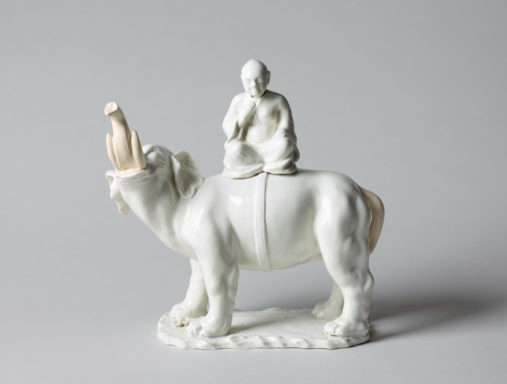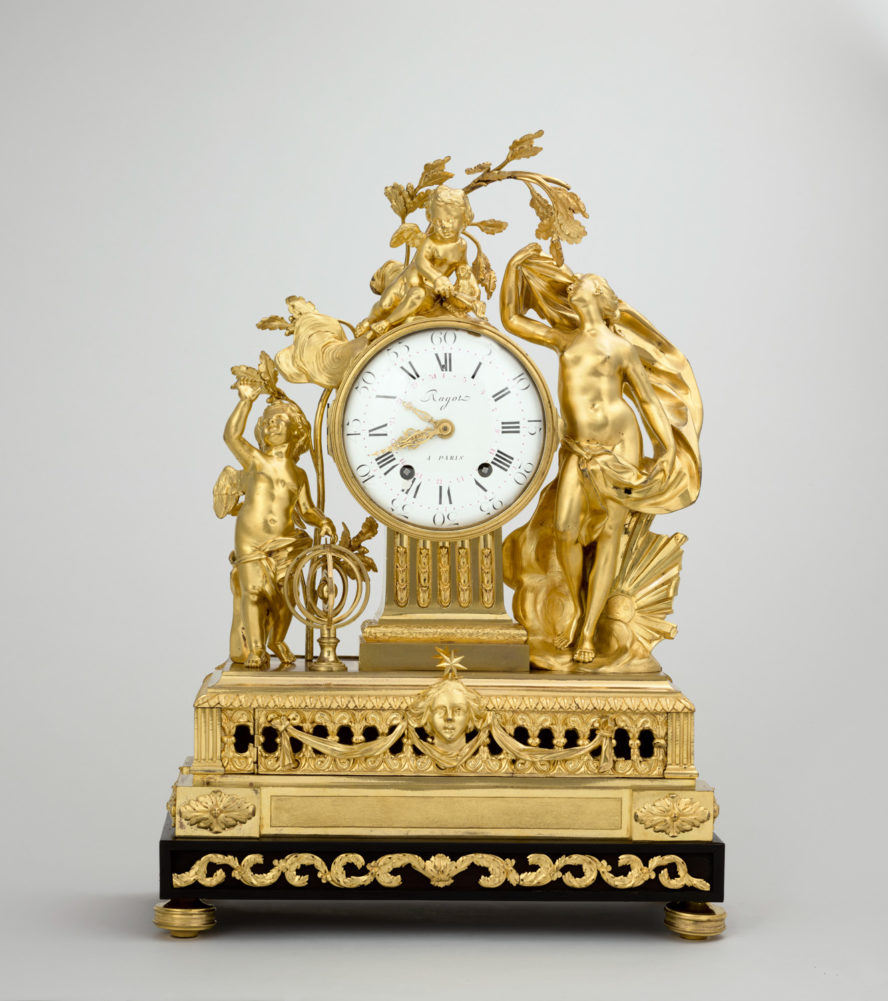
Europa abducted by the bull
Anonymous
1st century A.D.
The Guard Room
Europa abducted by the bull - 1st century A.D.
Artist : Anonymous
Nymphaeum mosaic from the Villa San Marco in Stabiae (Campania), located between Pompeii and Herculaneum. After it was discovered in 1752, the Europa panel joined the collection of Charles III, King of Naples, and was acquired by the Duke of Aumale in 1854, with the rest of the collection owned by the Prince of Salerno, Charles III’s son. The panel shows the abduction of the Phoenician princess Europa by Zeus, metamorphosed into a bull to avoid making his wife Hera jealous.

Enamelled faience tile panels: Mucius Scaevola at the camp of Porsenna
Masséot Abaquesne
1542
The Vestibule d’Honneur
Enamelled faience tile panels: Mucius Scaevola at the camp of Porsenna - 1542
Artist : Masséot Abaquesne
Between the columns of the Vestibule d’Honneur, the Duke of Aumale had two enamelled faience panels installed. The latter were executed in Rouen in 1542 by the great faience manufacturer Masséot Abaquesne. These panels were a prestigious commission by Constable Anne de Montmorency for his Château d’Ecouen. They were part of a cycle on Roman heroes.

Stained glass windows depicting the story of Psyche
Anonymous
1542-1544
The Psyche Gallery
Stained glass windows depicting the story of Psyche - 1542-1544
Artist : Anonymous
The Duke of Aumale had the Psyche Gallery laid out specifically to accommodate forty-four Renaissance stained glass windows from the Château d’Ecouen. Bequeathed in 1830 by his grand-uncle, the Duke of Bourbon, they were executed between 1542 from 1544 on commission from Constable Anne de Montmorency for his Château d’Ecouen. It is very rare for secular stained glass windows such as these, depicting non-religious iconographic themes, to have remained intact to this day. They are painted in grisaille with silver yellow stain highlights.
The sketches used to make these stained glass windows are attributed to the Flemish painter Michel Coxcie. They are copies of engravings (held by the Condé Museum) attributed to the Master of the die, an anonymous Italian engraver who copied the works of Raphael.
These stained glass windows are accompanied by thirty poems featuring eight verses. The authors are Claude Chappuys, La Maison Neuve and Mellin de Saint Gelais. These poems appear in quatrains in the windows. The latter recount the fable of Cupid and Psyche, and faithfully illustrate the text of The Metamorphoses, a novel by Apuleius, a second century A.D. Latin author. The tale is presented by Apuleius as an entertaining story, told by a slightly inebriated old lady who tries to console a young girl abducted by bandits on her wedding day. But this novel on the metamorphoses of the soul and the worship of Isis is above all a coming-of-age story.

Chinese Magot on an Elephant
Anonymous
Circa 1735-1740
The Orleans Room
Chinese Magot on an Elephant - Circa 1735-1740
Artist : Anonymous
A substantial soft porcelain manufactory was created in Chantilly in 1725, under the patronage of Louis-Henri, Prince of Condé. Its production was influenced by a fascination at that time for an imagined Asia, one symbol of which was the elephant.

Pair of pot-pourri holders
Anonymous
Circa 1740
The Orleans Room
Pair of pot-pourri holders - Circa 1740
Artist : Anonymous
Up to the mid-19th century, Chantilly porcelain was decorated in a style known as Kakiemon, from the name of the Japanese creator of the kilns in Arita, in Japan, in the 17th century. Here two ferocious leopards of Asian inspiration guard pot-pourri holders in the Kakiemon style: pride of place for the white porcelain, stylised patterns, minimal palette.

Clock
Anonymous
Circa 1740
The Prince’s Bedroom
Clock - Circa 1740
Artist : Anonymous
This magnificent clock with Boulle tortoiseshell and bronze marquetry, lavishly decorated, is typical of the Regency period. The gilt-bronze feet form brackets and are adorned with women’s heads emerging from a volute of acanthus leaves wearing feather hats.
The lower part features a gilt-bronze bas-relief representing a half-naked woman, riding side saddle on a winged horse. The back of the case is decorated with a veneer of ebony and bronze marquetry, and at its centre features a bouquet of flowers in a vase amidst interlacing foliage. The dome is topped with a figure in the round depicting Time sitting on a sphere.

Cartel
Charles Cressent & Etienne Lenoir movement
Circa 1745-1749
The Rotunda / The Gallery of Painting
Cartel - Circa 1745-1749
Artist : Charles Cressent & Etienne Lenoir movement
This rococo-style clock is based on the first model created by the artist around 1735. It is part of a series of clocks with masks portraying women wearing shells in their hair. The feet of these clocks are enriched with palms, and their dials are highlighted with flower drops. Two dragons face each other, and in the middle of these we see the head of a child blowing air through its mouth, who can be identified as Boreas, Aeolus or Zephyr.

Three Graces Clock
Anonymous
Circa 1775
The Violet Room
Three Graces Clock - Circa 1775
Artist : Anonymous
The Three Graces clock is probably one of the Condé Museum’s most famous timepieces. The mechanism is contained in a celestial sphere supported by three Graces standing on a triangular white marble base. Triangular in form, with rounded angles, this base is adorned with delicate openwork gilt-bronze. The Three Graces, all identical, support themselves on their right legs, with their left legs lifted slightly to the rear. They support the sphere with their raised arms, and their heads, adorned with a ribbon, are tilted slightly backwards. Large garlands of roses and leaves hang from their hands. The sphere is made of painted tole adorned with gilt-bronze elements: stars in the upper hemisphere and a cloud crowned with a cupid shooting an arrow (which has disappeared) from his bow. On the lower hemisphere, ribbed leaves frame six stems adorned with flowers. Between the two hemispheres, a mobile enamel dial is bordered by two gilt-bronze cords. A fixed black arrow indicates the passing hours.
The model for this clock was invented by François Vion around 1765 (a model that belonged to Madame du Barry): Vion is said to have drawn inspiration from a clock featuring the three Graces by Falconet, held at the Louvre Museum. The model was quite popular in the 19th century. The clock in the Condé Museum may date from the period when France was governed by the Directory.

Pedal harp known as “perpendicular harp”
Frederick Dizi & Thomas Dodd
between 1813 and 1851
The Music Room
Pedal harp known as “perpendicular harp” - between 1813 and 1851
Artist : Frederick Dizi & Thomas Dodd
This English harp very probably belonged to the Duchess of Aumale, who was an excellent musician (she especially liked the piano). This instrument, which had been particularly fashionable since the end of the 18th century, features the latest technical innovations.

Gilt-bronze clock featuring Venus Anadyomene with two cupids
Ragot
Between 1830 and 1840
The Graphic Arts Room
Gilt-bronze clock featuring Venus Anadyomene with two cupids - Between 1830 and 1840
Artist : Ragot
This Louis XVI style clock was made in the first half of the 19th century, probably around 1830-1840, by the clockmaker Ragot. It features Venus Anadyomene accompanied by two cupids. This is a representation of the famous mythological episode of the birth of the Goddess rising from the sea. The characters surround the dial, which sits on the shaft of an antique style column. The base, made from black wood decorated with a gilt-bronze plant border, sits on gilt-bronze circular feet. This clock’s motion has never been modified, which is rare. The base of the case features a space intended for organ pipe or chime motion. As is often the case, this musical mechanism unfortunately disappeared.

Vase with Scenes of historic courtly hunts in France
Anonymous
1846
The Gallery of Battles
Vase with Scenes of historic courtly hunts in France - 1846
Artist : Anonymous
This large vase is one of a pair. One was given by Louis-Philippe as a gift to the Bey of Tunis, and the other to the Duke of Aumale in 1847.
The vase in Chantilly shows four historic hunting scenes: Catherine de Medici hunting with a crossbow in front of the Château de Chambord; Louis XIII having a hunting lodge built in the Versailles woods in 1622; Louis XIV and the King of England in exile hunting together in Saint-Germain-en-Laye in 1689; and a night hunt in Chantilly, organised for the future Czar Paul I of Russia when he came to Chantilly in 1781. This imposing vase bears witness to the historicist vogue in decorative art under the July Monarchy.



































